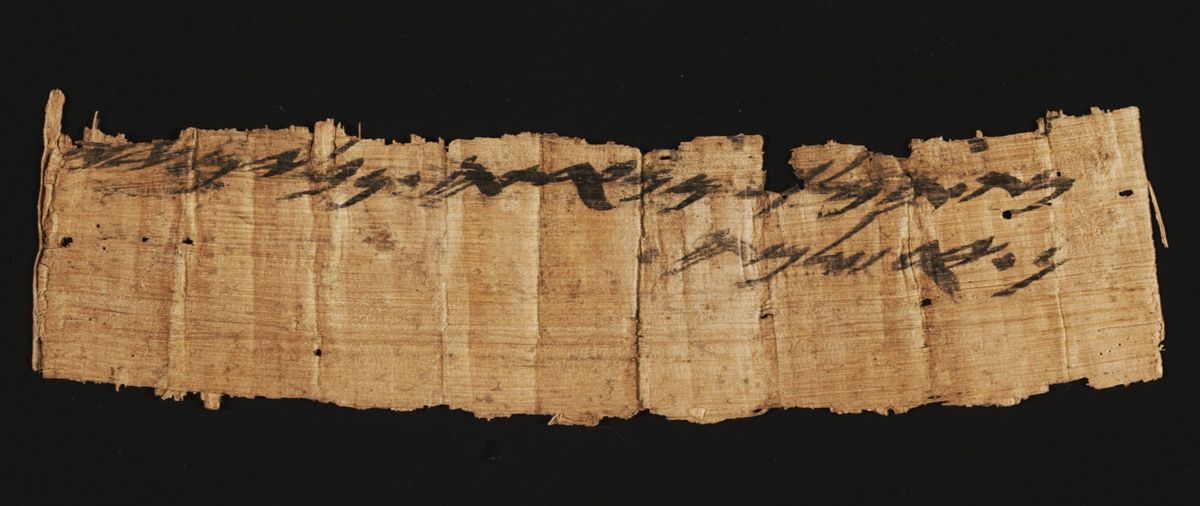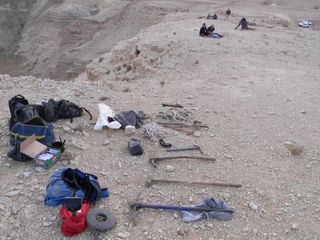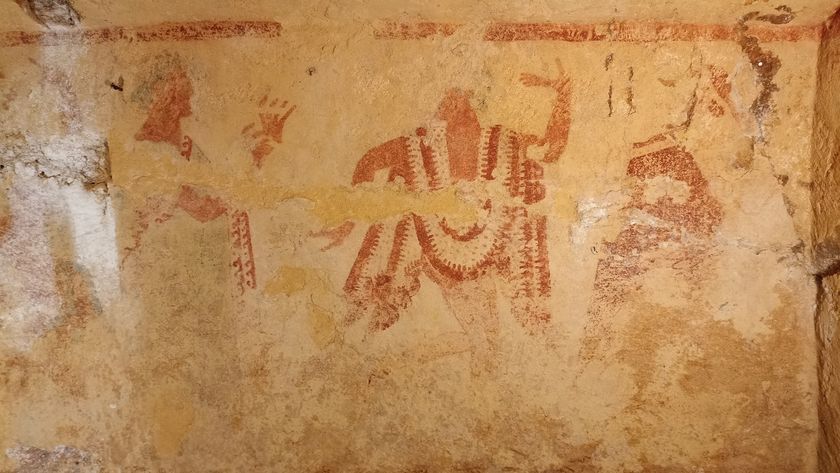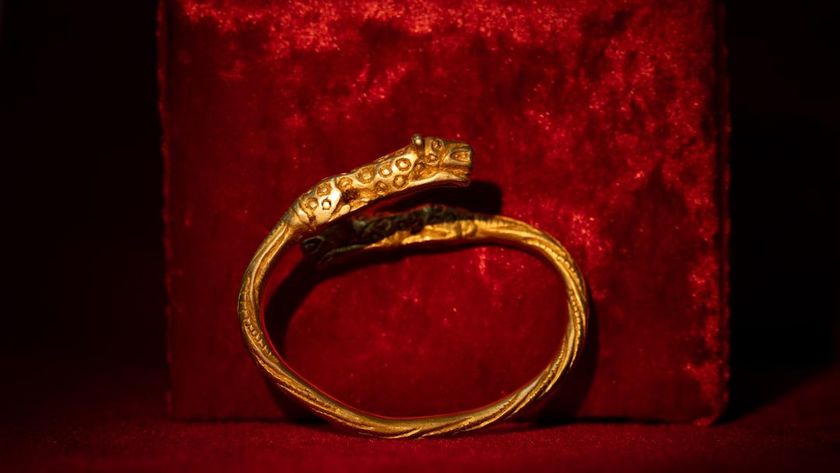Ancient Hebrew Papyrus Seized from Looters, But Is It Authentic?

A rare, 2,700-year-old papyrus with Hebrew script that had been looted from a cave in the Judean Desert has been seized in an elaborate operation by the Israel Antiquities Authority, archaeologists announced today (Oct. 26).
However, a professor at George Washington University has provided information to Live Science indicating that the papyrus may be a sophisticated modern-day forgery.
The papyrus' Hebrew text translates as: "from the king's maidservant, from Na'arat, jars of wine, to Jerusalem," the capital city of the Kingdom of Judah, according to a statement from the Israel Antiquities Authority (IAA).
The document indicates "payment of taxes or transfer of goods to storehouses in Jerusalem, the capital city of the kingdom at this time," the IAA statement read.
"This is the most ancient mentioning of Jerusalem outside of the Bible in Hebrew script," said Eitan Klein, who holds a doctorate in archaeology and is the deputy director of the Unit for the Prevention of Antiquities Robbery, which seized the papyrus. [See Images of the Rare Hebrew Papyrusfrom the Judean Desert]
Carbon dating and an analysis of the writing on the papyrus suggest it dates to the seventh century B.C., Klein said. The operation carried out to save the papyrus revealed that the looters found it in a cave located in the Nahal Hever valley, Klein said. He added that he can't reveal the cave's name in order to keep looters away.
If authenticated, this papyrus would be one of only two Hebrew papyri that date as far back as the seventh century B.C., said Shmuel Ahituv, a retired professor at Ben-Gurion University of the Negev, in the statement. The suggestion in the writing that a woman ("the king's maidservant") held an administrative post that allowed her to oversee the transport of wine to Jerusalem is also interesting, Ahituv said.
Sign up for the Live Science daily newsletter now
Get the world’s most fascinating discoveries delivered straight to your inbox.
Tracking the looters
Klein told Live Science how the elaborate operation to seize the papyrus was carried out.

"We got information about a Palestinian group of looters from the southern Hebron Hills who were digging at the Nahal Hever in the Judean Desert," said Klein, adding that his unit "got reliable information that they found a scroll." This occurred about three years ago, Klein said, declining to give a specific date when the tip first came in.
However, Christopher Rollston, a professor of Northwest Semitic languages and literatures at George Washington University, told Live Science that he saw the scroll three years ago however it was not in a cave.
"I [saw] some good images in Jerusalem about three years ago. Nice images. It wasn't in some cave three years ago," he wrote in an email. In a post on his blog, he said that the papyrus "is from the antiquities market and it has been floating around on the market for a few years now." [Photos: Israeli Police Seize Stolen Ancient Coffins]
Klein said that three years ago his team was tracking the looters through the Judean Desert. "We succeeded to track [the] group of looters from the Judean Desert until the point that they tried to sell it to someone in the antiquities market in Jerusalem," Klein said, declining to say when his team first encountered the scroll in Jerusalem.
Even though the looters hadn't succeeded in selling it, they had passed the scroll to intermediaries who were trying to facilitate the sale, he said.
Live Science heard a rumor that the IAA had paid someone to give the papyrus to the team so that the scroll would not be harmed during a raid. When asked whether this rumor was true, Klein said: "I cannot specify exactly how we got it, but it was very complex and eventually, no [we didn't pay them]."
Klein didn't deny, however, that money had changed hands, at least at one point during the operation. "I cannot specify about that," he said.
Klein's team continued to track down the looters, ultimately arresting them in the Judean Desert. "We caught the group of looters in the field when they excavated at other caves," he said.
During the operation to seize the scroll, Klein's team identified two other groups of looters who were also from the southern Hebron Hills and caught them, seizing more ancient texts in the process.
The unit identified three caves in three separate valleys in the Judean Desert where looting activities were underway. Rescue operations were carried out to excavate the remaining artifacts, including two scroll fragments dating back around 2,000 years, in those caves.
Is it authentic?
"There are some palaeographic anomalies and inconsistencies in this papyrus inscription that suggest it may be modern, not ancient," Rollston said.
He added that "the fact that the papyrus itself has been carbon-dated to the seventh century BCE certainly does not mean that the writing on the papyrus is ancient. After all, ancient papyrus is readily available for purchase online, thus, no modern forger worth his salt would forge an inscription on modern papyrus. Rather, he would purchase some ancient papyrus online and then write a text on it. It happens fairly often."
Sometimes even the most authentic-looking scroll can be a forgery. For instance, Live Science recently reported on 70 new "Dead Sea Scroll" fragmentsthat had appeared on the antiquities market over the last 15 years. Scholars have expressed concern that some of the new scrolls could be forgeries, while others could be from looting in the Judean Desert. [See Photos of the Dead Sea Scrolls Fragments]
Klein said that he has no doubt this 2,700-year-old papyrus is authentic, partly because his team knows exactly where it was found three years ago.
It's possible that the Israel Antiquities Authority was fooled by forgers who managed to throw them off the scroll's true origins, Rollston said. "Forgeries are often reported to have been found here, or there, at some specific location," wrote Rollston on his blog.
Klein says he will need to talk to Rollston and compare notes before he can comment further. He said that he is interested in hearing what Rollston knows about the papyrus.
Original article on Live Science.

Owen Jarus is a regular contributor to Live Science who writes about archaeology and humans' past. He has also written for The Independent (UK), The Canadian Press (CP) and The Associated Press (AP), among others. Owen has a bachelor of arts degree from the University of Toronto and a journalism degree from Ryerson University.
Most Popular




